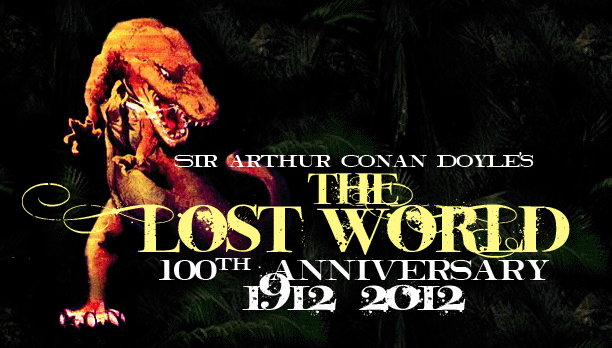|
Challenger's Dinosaur
In a 1996 scientific paper, D.M. Martill, A.R.I. Cruickshank, E. Frey, P.G. Small, and M. Clarke described a new meat eating dinosaur discovered in the north-western corner or Brazil... practically in Maple White Land itself! This new dinsoaur was named Irritator challengeri: the generic "Irritator" because it was irritating for the authors to describe, and the specific "challengeri" "From Professor Challenger, the fictitious hero and dinosaur discoverer of Sir Arthur Conan Doyle's [The] Lost World."
I. challengeri is known only from the 80 cm long skull of what appears to be an odd looking, crested, fish-eater. Original studies placed Challenger's dinosaur in the same group which includes the ostrich-mimic dinosaurs and crafty predators like Troodon formosus. However, reevaluation has placed Irritator in the spinosaurids, occupying the same family as Baryonyx, Suchomimus, and Jurassic Park III's Spinosaurus. The studies have also found that Irritator did not have as pronounced a crest as originally thought.
Of the naming of his discovery, Dr. David M. Martill says:
"Conan Doyle was the first person to write an adventure story around dinosaurs... In addition, Conan Doyle invented a lost world based on the descriptions of high remote plateaus in the Amazon region. In north east Brazil there is such a plateau, known as the Chapada do Araripe. it is not so remote, but it has jungle clad sides and often has it's summit in the clouds. It is also one of the best places for fossils in the world." He goes on to say: "...we felt that the character he created (Prof. Challenger) was such a colourful character that we wanted to get him in on the act. As he was a stubborn old git, and as the fossil dinosaur called Irritator presented a difficult challenge, we called it 'challengeri'. Thus it is a combination of Brazil, a lost world and a difficult specimen." (from a personal communication, Wednesday May 14th, 1996).
Articles
- Through Brazil to the Summit of Roraima
- Learn about the tepuis of South America though excerpts from this 1930 National Geographic article.
- The Lost World Bestiary
- A Gallery of Victorian & Edwardian Palaeontology.
- Cryptozoology
- Hidden animals and lost worlds, crypotzoology beyond pseudoscientific fancy.
Links
- The Real Lost World
- Official web site for The Real Lost World documentary.
- Lost World 2001
- The official site of another expedition to the Gran Sabana in 2001.
- Living Edens: The Lost World
- Eco-Explorer site by PBS' Nature program.
- The Lost World: Canaima National Park in Venezuela
- UNESCO's official Canaima National Park list site, with media.
- The Lost World
- An extensive website on Venezuela, the Gran Sabana, and Canaima National Park.
- Lost World Adventures, The Real Lost World Adventure, Angel Eco Tours, G.A.P. Adventures: The Lost World
- Tour guides specializing in South American excursions. Note: Silent Movie Monsters does not specifically endorse these companies or their services.
- Lost World Caverns
- Site for the tourist-friendly caves in Lewisburg, Virginia.
The Lost World or the lost mind?
Unfortunately, for every piece of good science, there has to come a piece of bunk pseudoscience. For The Lost World, that usually comes in the vain hope that there may be some kind of living dinosaurs on the real Mount Roraima. However, in the strange world of Mark Stephen Smith's The Lost World Adventures, the Creationist Prof. Challenger and the staunchly evolutionist Prof. Summerlee venture into the Amazon and discover the supposed ultimate reproof of evolution: a land of living dinosaurs.
That there aren't actual living dinosaurs perhaps escapes the authour (as it does other Creationists, who frequently attempt to use the pseudoscience of cryptozoology to prove the pseudoscience of Creationism), but it is nevertheless quite poor form to twist a literary classic built on a fascination with exploration and prehistoric life to rob children of their appreciation for the real world that God created and the real evolutionary processes by which He created it.
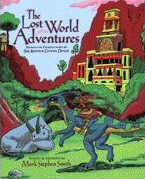
|
The true scientific mind is not to be tied down by its own conditions of time and space. It builds itself an observatory erected upon the border line of present, which separates the infinite past from the infinite future. From this sure post it makes its sallies even to the beginning and to the end of all things."
Conan Doyle, The Poison Belt.
Since the beginning, The Lost World has both been inspired by and in turn inspired expeditions to the Gran Sabana region of South America. Situated on the shared border of Venezuela, Brazil and Guyana, the Gran Sabana is notable for its vast expanse of table-top plateaus called "tepuis", upon which Sir Arthur Conan Doyle situated his antediluvian ecology.
We know, of course, of how Conan Doyle was inspired by the stories of South America by explorers like Everard im Thurn. But almost no sooner had The Lost World been written than it was used to drum up support for further exploration. On June 17th, 1925, the newly reopened New Gallery Cinema of London held a matinee of the original Lost World film in aid of the British Museum Fund for Exploration in South America. Prior to the show, Sir Sidney Harmer gave a lecture on the efforts of W.E. Cutler in prospecting dinosaur fossils in the Tanganyika of Africa. The New York Times of March 25th, 1925, reported "WOMAN EXPLORER SEEKS 'LOST WORLD'":
Miss Katherine MacGregor, the young explorer who was the first white woman to cross the Andes over the trail from Lima, Peru, to Para, at the mouth of the Amazon River, three years ago, will sail today on the steamer Panama in quest of new adventures in the jungle of South America...
From Cristobal, panama, she will start for the interior of Colombia, sailing up the Magdalena River by canoe. taking up the trail there for the wild interior country, she will search for the so-called "lost world" and will then visit the settlement of the macas in Ecuador and also invade the haunts of the Jivaros, or head-hunters, of Ecuador.
Numerous explorations were planned to that far-flung region of South America. Popular Science charted it on their April 1932 map entitled "The Science of Exploration", while the October 1931 Popular Mechanics published a map of the route to be taken by an aerial expedition.
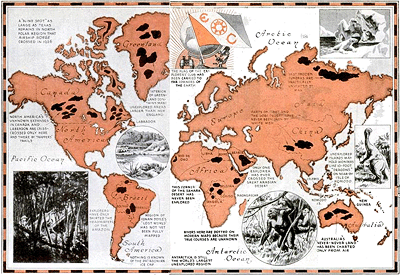
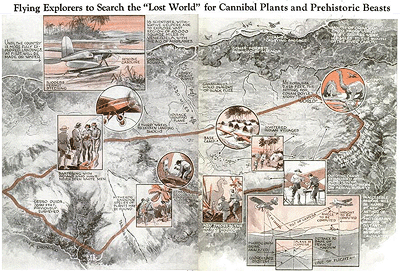
Click on thumbnails to see larger image.
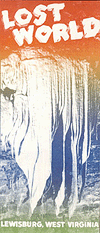 The Lost World has even inspired places to be named in its honour. Lewisburg, West Virginia, United States of America, is home to the Lost World Caverns: a 11/4 mile long cave system that reaches a depth of 235' below ground and maintains a constant temperature of approximately 11 degress Celsius. Discovered in 1942 and presumably named after Conan Doyle's tale, the caverns boast one of America's largest stalactites (weighing in at an impressive 30 tons) named the "Snowy Chandelier", as well as other imaginative features named the "Bridal Veil" and the "War Club". The tourist complex also includes a private museum of dinosaur and prehistoric animal fossils, and the remains of a cave bear were discovered in the cave in 1967. The Lost World has even inspired places to be named in its honour. Lewisburg, West Virginia, United States of America, is home to the Lost World Caverns: a 11/4 mile long cave system that reaches a depth of 235' below ground and maintains a constant temperature of approximately 11 degress Celsius. Discovered in 1942 and presumably named after Conan Doyle's tale, the caverns boast one of America's largest stalactites (weighing in at an impressive 30 tons) named the "Snowy Chandelier", as well as other imaginative features named the "Bridal Veil" and the "War Club". The tourist complex also includes a private museum of dinosaur and prehistoric animal fossils, and the remains of a cave bear were discovered in the cave in 1967.
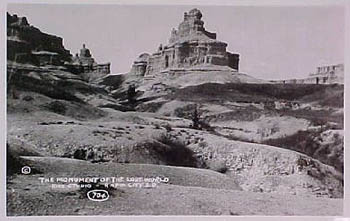
Postcard of the Monument of the Lost World, South Dakota.
This section of the site is devoted to the various real world expeditions to the Lost World, as well as aspects of the science and history behind the Challenger Adventures.
- Climb to the Lost World by Hamish MacInnes, Hodder and Stoughton (1974) and BBC Roraima Expedition to the Lost World by Don Whillans, Joe Brown, Hamish Macinnes, Mo Anthoine (Dirs.), BBC (1973)
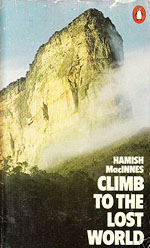 Climb to the Lost World outlines Scottish mountaineer MacInnes' journey to the Gran Saban region of Venezuela and ascent of the imposing Mount Roraima in November of 1973. Taking a BBC film crew along with him, they retraced the steps of Everard im Thurn with narration linking their adventure to that of Conan Doyle's heroes. That footage became the 1973 film special. Climb to the Lost World outlines Scottish mountaineer MacInnes' journey to the Gran Saban region of Venezuela and ascent of the imposing Mount Roraima in November of 1973. Taking a BBC film crew along with him, they retraced the steps of Everard im Thurn with narration linking their adventure to that of Conan Doyle's heroes. That footage became the 1973 film special.
The chosen point of ascent for MacInnes and the BBC crew was the feature known as "The Great Prow", a jutting pinacle of rock on the Guyana side of Roraima. It was that Prow which served either as the inspiration for the pinacle that allowed Challenger's expedition to reach the plateau or it quickly became associated with it.
Review by Cory Gross.
- Quest for the Lost World by Brian Blessed, Boxtree/Macmillan Publishers(1999)
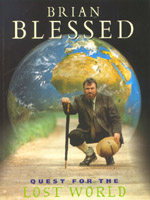 In Quest for the Lost World, actor Brian Blessed (perhaps most famous in North America for his role as the crazed king in Blackadder and the voice of Clayton in Disney's Tarzan) takes us along on the fulfillment of his childhood dream to visit the Gran Saban in Brazil, setting of The Lost World. In Quest for the Lost World, actor Brian Blessed (perhaps most famous in North America for his role as the crazed king in Blackadder and the voice of Clayton in Disney's Tarzan) takes us along on the fulfillment of his childhood dream to visit the Gran Saban in Brazil, setting of The Lost World.
This is largely an autobiographical work, but Blessed's homages to Conan Doyle and his desire to seek out adventure will no doubt resonate with Lost World fans and anyone who sees someplace new to them as a blank spot on the map full of wonder and mystery. Blessed takes his readers around the world and through every conceivable hardship, introducing them to mountain splendour through his eyes. And it all culminates in his setting foot upon the elusive Mount Roriama, inspiration for The Lost World.
The writing is in a very readable and familiar style, which makes for an enjoyable and easy armchair adventure (he somehow manages to make you feel like an old bloke of his).
Review by Cory Gross.
- Dinosaur Movies by Don Glut (Dir.), Popcorn Pictures (1993)
- Dinosaur Movies is, by this point, a difficult-to-find treasure. Hosted by dinosaur pop-culture expert "Dinosaur" Don Glut and co-hosted by Christy Block, this usually corny but always reverent documentary chronicles the the history of dinosaur films right up to just before Jurassic Park took over and reshaped the genre. Featuring interviews with Ray Harryhausen, Forrest J. Ackerman and Jim Danforth, this 2-tape VHS set includes, as supplemental features, the best and clearest prints I've ever seen of Willis O'Brien's Dinosaur and the Missing Link and Creation test footage, as well as Gertie the Dinosaur, with original music by Glut.
Of particular interest to The Lost World fans is the various rare footage involving Willis O'Brien and the production of the original film. Included are screen shots of O'Bie's previous The Ghost of Slumber Mountain and some of his comedic shorts made for Thomas Edison's film company. There is a commentary on 1925's film, as well as footage from it (amounting to various fight scenes, the dinosaur stampede/volcano explosion and the brontosaurus loose in London). Mr. Science Fiction, Forrest J. Ackerman, supplies amusing anecdotes about his lost world experiences and shows viewers a bit of his (now former) collection of memorabelia.
At this point, almost 15 years after this VHS was produced, you're lucky to find Dinosaur Movies on online auctions or used video services. But for the fan of The Lost World and the genre of dinosaur films in general, this is so essential that someone really ought to obtain the rights to reproduce it even on custom ordered DVD-R's.
Review by Cory Gross.
- The Real Lost World by Peter von Puttkamer (Dir.), Gryphon Productions (2006)
- A documentary feature released in 2006, The Real Lost World seems to be fulfilling two mandates. On the one hand is a romantic and adventuresome expedition to Mount Roraima tied to the Conan Doyle novel and on the other is a serious scientific expedition to explore the still largely uncharted cave system underlying the mount and assess microbiological lifeforms that, somehow, still cling to life in this forbidding environment.
The documentary is very deftly divided into three concurrent narratives... In a simulated sepia-tone, the original discovery and scaling of Roraima by Everard Im Thurn is reinacted. Meanwhile, The Lost World is discussed via clips from the 1925 film and the BBC mini-series, as well as the expert comentary of Doylian scholar Richard Milner. Finally, there are scenes from the modern expedition.
The main figures in the modern expedition are biologist Hazel Barton and cryptozoologist Dean Harrison, who provide the dramatic internal conflict within the group as the NASA scientist and accredited PhD. squares off over methodology with the rugged, Crocodile Hunter-inspired seeker of living dinosaurs. Despite run-ins with giant anacondas, you know that they aren't going to find living palaeontological specimens from 130 million years ago. However, Harrison keeps this sexy, cinematic possibility alive long enough (if not quite credibly enough) to capture the interest of a public who might otherwise not be altogether that fascinated with Barton's discovery of a microbe that breaks down silicon, as important as that may be.
Nevertheless, it is an excellent production that fuses different strains of interest in The Lost World, from the original expeditions that inspired Conan Doyle to the text itself and back to the plateau. One hopes that this gets its due mileage on television and eventually works its way into DVD release.
Review by Cory Gross. Official Web Site.
Trailer for The Real Lost World by Gryphon Productions
- Planet Earth by Alastair Fothergill (Prod.), BBC (2006)
- The "Fresh Water" episode of this magnificent High Definition documentary series begins with a look at the tepuis of Venezuela. The tepuis endure a pelting of rainfall almost every day and are one of the sources of the great freshwater ways that winds through South America. With stunning photography as one of the series' main features, this sequence does not disappoint. As its climax, there is an absolutely astonishing aerial shot of Angel Falls: a tepuis waterfall that is the largest in the world... So high that the water blows away as mist before reaching the bottom.
Review by Cory Gross. Official Web Site.
|
